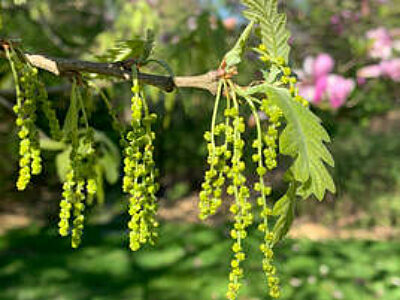When I was growing up, particularly during my teenage years, my father used to counsel, “All things in time.”
Thirty years ago, he and I came upon an impressive stand of bur oaks (Quercus macrocarpa). He took a handful of acorns and potted them up, planting the seedlings on my property two years later. Today, the trees are more than 30 feet tall, magnificent specimens that delight me in all seasons. They remind me of my father and somehow seem to embody his values, his way of looking at the world.

In the spring, the oak produces male and female flowers on the same branch. The long and pendant “catkins” are male. The Farmer’s Almanac advises planting corn when oak leaves are the size of a mouse’s ear. In the summer, the mature leaves are lobed and rounded, glossy, wider at the top – and occasionally home to “oak galls,” which, I am told, were once the source of ink. In the fall, the leaves turn a nondescript brown but, unlike most oak leaves, do not hang on through the winter.
In the fall, one can see the distinguishing feature of the bur oak, a “mossy” or fringed bur-like cap that covers most of the acorn. But to my mind, the tree is most beautiful after the leaves have fallen in the fall and winter because, with its spreading, gnarled, and twisted branches, it has that classic spooky “Halloween” look!
The stems and bark of the tree are grey, cork-like, and deeply furrowed. The oak’s distinctive bark makes it fire tolerant and thus able to survive the prairie fires caused by lightning strikes or set by Native Americans: fire is critical in maintaining the prairie’s ecological balance.
Periodically, in “mast years,” my bur oaks produce heavy crops of acorns. These attract squirrels (of course) to the yard, but deer and jays and turkeys as well as, on one memorable occasion, a young black bear. The squirrels dutifully bury the acorns in mulch and in the tilled soil of the vegetable garden. Every year, I pot up the seedlings and give them away to fellow gardeners who have the room for these massive trees, the fastest growing of all the American oaks. The trees seem to thrive, even in the heavy clay soil I struggle with.

It may be relatively uncommon to find the bur oak in New York State: my father had to resort to a field guide to identify the tree. However, visitors to Landis can view several mature specimens in the Arboretum’s Oak Collection. Bur oaks, a species of the more common white oak, seem to be more prevalent in the Midwest, where they tower, silent sentinels, over the prairie in those areas that have been preserved from development.
The stately and soulful bur oaks that line the streets of Oak Park, Illinois, are descendants of the oak savanna that pre-dated the arrival of the Europeans. They are a beautiful and monumental complement to the nature-inspired architecture of Frank Lloyd Wright, whose buildings are a hallmark of this Chicago suburb. Many of these trees were propagated from several 200 – 300 year-old native bur oaks as part of the Historic Oak Propagation Project.
Several huge bur oaks must have been planted years ago along one of the roads near my home. One of the trees has a metal piece embedded in its trunk. I wonder if the original owner of the nearby Walter Butlersbury home (1742) had a hand in planting them. (The home, incidentally, also has a lovely grove of ancient locusts.)
The bur oaks in front of my house, on the prairie, and on the nearby road, seem to embody time. In nature, however, time moves infinitely more slowly than in man’s world. The poet Rabindranath Tagore wrote that “the one who plants trees, knowing that he will never sit in their shade, has at least started to understand the meaning of life,” a valuable lesson my father taught me, when 30 years ago, he planted the trees in whose shade he would never sit.
For further reading:
Peattie, Donald Culross. A Natural History of Trees of Eastern and Central North America. Boston, MA, Houghlin Mifflin Company, 1948.
Tallamy, Douglas W. The Nature of Oaks: The Rich Ecology of Our Most Essential Native Trees. Portland, OR, Timber Press, 2021.
